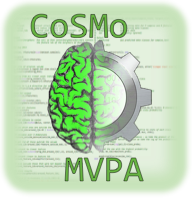%% MEEG time generalization in a region (in space-time) of interest
%
% This example shows MVPA analyses performed on MEEG data.
%
% The input dataset involved a paradigm where a participant saw
% images of six object categories.
%
% The code presented here can be adapted for other MEEG analyses, but
% there please note:
% * the current examples do not perform baseline corrections or signal
% normalizations, which may reduce discriminatory power.
%
% Note: running this code requires FieldTrip.
%
% # For CoSMoMVPA's copyright information and license terms, #
% # see the COPYING file distributed with CoSMoMVPA. #
%% get timelock data in CoSMoMVPA format
% set configuration
config = cosmo_config();
data_path = fullfile(config.tutorial_data_path, 'meg_obj6');
% show dataset information
readme_fn = fullfile(data_path, 'README');
cosmo_type(readme_fn);
% reset citation list
cosmo_check_external('-tic');
% load preprocessed data
data_fn = fullfile(data_path, 'meg_obj6_s00.mat');
data_tl = load(data_fn);
% convert to cosmomvpa struct and show the dataset
ds = cosmo_meeg_dataset(data_tl);
cosmo_disp(ds);
%%
% set the targets (trial condition)
% Hint: use the first column from ds.sa.trialinfo
%%%% >>> Your code here <<< %%%%
% set the chunks (independent measurements)
% all trials are here considered to be independent
%%%% >>> Your code here <<< %%%%
% in addition give a label to each trial
index2label = {'body', 'car', 'face', 'flower', 'insect', 'scene'};
ds.sa.labels = cellfun(@(x)index2label(x), num2cell(ds.sa.targets));
% just to check everything is ok
cosmo_check_dataset(ds);
%% Select subset of sensors and time points
% Select posterior gradiometers
sensor_posterior_planar = {'MEG1632', 'MEG1642', 'MEG1732', 'MEG1842', ...
'MEG1912', 'MEG1922', 'MEG1942', 'MEG2232', ...
'MEG2312', 'MEG2322', 'MEG2342', 'MEG2432', ...
'MEG2442', 'MEG2512', 'MEG2532', ...
'MEG1633', 'MEG1643', 'MEG1733', 'MEG1843', ...
'MEG1913', 'MEG1923', 'MEG1943', 'MEG2233', ...
'MEG2313', 'MEG2323', 'MEG2343', 'MEG2433', ...
'MEG2443', 'MEG2513', 'MEG2533'};
msk = cosmo_dim_match(ds, 'chan', sensor_posterior_planar, ...
'time', @(t)t >= 0 & t <= .3);
ds_sel = cosmo_slice(ds, msk, 2);
ds_sel = cosmo_dim_prune(ds_sel);
% Reduce the number of chunks to have only two chunks
% Hint: use cosmo_chunkize
%%%% >>> Your code here <<< %%%%
% Now use cosmo_dim_transpose to make 'time' a sample dimension, and
% assign to ds_tr
% Hint: the third argument to cosmo_dim_transpose must be 1, because
% time now describes the first (sample) dimension in .samples
%%%% >>> Your code here <<< %%%%
cosmo_disp(ds_tr);
% Set the measure to be a function handle to
% cosmo_dim_generalization_measure
%%%% >>> Your code here <<< %%%%
% Set measure arguments
measure_args = struct();
% Use the measure with the following arguments:
% - measure: @cosmo_crossvalidation_measure
% - classifier: @cosmo_classify_lda
% - dimension: 'time'
%%%% >>> Your code here <<< %%%%
% Now apply the measure to the dataset, and store the output in a variable
% 'result'
%%%% >>> Your code here <<< %%%%
%% Visualize results
% Unflatten the dataset using cosmo_unflatten, and assign the result
% to three variables: data, labels and values
% Hint: the second argument to cosmo_unflatten must be 1
%%%% >>> Your code here <<< %%%%
% Visualize the data matrix using imagesc
%%%% >>> Your code here <<< %%%%
colorbar();
% Show labels
nticks = 5;
ytick = round(linspace(1, numel(values{1}), nticks));
ylabel(strrep(labels{1}, '_', ' '));
set(gca, 'Ytick', ytick, 'YTickLabel', values{1}(ytick));
xtick = round(linspace(1, numel(values{2}), nticks));
xlabel(strrep(labels{2}, '_', ' '));
set(gca, 'Xtick', xtick, 'XTickLabel', values{2}(xtick));

